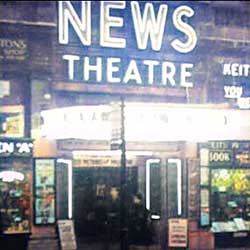News /newsreels at the cinema in the 1940s and 50s

With no television in homes, the only way for ordinary people to get news commentaries with motion pictures was at the cinema. This news was known as a newsreel or newsreels because it was on reels of film, and it was extremely popular. The following page describes how the news was shown sandwiched between two regular cinema films; why it was necessarily out-of-date, the benefit of watching in different cinemas and the importance and horrors of cinema news in WW2.
____
By the webmaster: her early recollections and further research with contributions from others who lived at the time
The cinema show format of the news and films in regular cinemas
Most cinemas had an afternoon show and an evening one, and the times for the beginning of each show were posted outside the cinema and in the local paper.
A typical cinema show consisted of a film, a newsreel, so called because it was on a reel of film, another film and trailers for future films. Once this first showing was complete, it was repeated for the evening show.
Newsreel content
contributed by Peter Johnson, childhood recollections
People often went to the pictures just to see the newsreel and then leave. They went for a boxing match, or a football match or some big battle that our troops had been involved in.
Newsreel theatres and cinemas
As well as regular cinemas showing the news, there were also 'Newsreel Cinemas' or 'Newsreel Theatres',. Their main purpose of was to show newsreel films continuously throughout the daytime period.
A problem with newsreel theatres
contributed by Darren Kitson, comment
One problem with newsreel theatres, especially during winter, was that they were attractive to vagrants and others who just wanted somewhere to sit and keep warm - if they could beg the money to get in.
Why cinemas news was likely to be out-of-date
A new show, with the same format, but with a change of films and newsreel was shown every week. This meant that the news was often out-of-date when we saw it, but it was very much better than nothing. (We could keep completely up-to-date with the daily newspaper and the radio - known then as the wireless - but that was without moving pictures.)
Common newsreel providers
Cinema news always seemed to me as a child to be put together by Pathe, whose emblem was a crowing cockerel with full sound effects. However, I now know that Pathe was merely the newsreel for my local Ritz cinema and that there were other newsreels at cinemas on a different franchise - see below.
contributed by Peter Johnson, childhood recollections
Regal Cinemas had British Gaumont News and our local Empire Cinema had Pathe News.
contributed by Malcolm Head
Our local newsreel where I lived in Wales was Movietone News.
contributed by Darren Kitson, comment
British Movietone was the British arm of the American Fox Movietone company, hence the use of the American word 'movie'.
The horrors of wartime newsreels
The Fall of Nanking on cinema newsreel
contributed by Peter Johnson, childhood recollections
There was one newsreel that I can remember to this day, even though I must have been younger than five years old at the time. It was in a Regal Cinema. To my horror I watched as babies were thrown into the air and then caught on the spikes of soldiers' bayonets; as women were buried alive; and thousands of dead bodies were lying in the streets. It was the Fall of Nanking, when the Japanese captured Nanking in China. If you can get this footage from the Gaumont archives, you can see for yourself. It is history in the raw.
Belsen, Dachau and other concentration camps on cinema newsreels
contributed by Malcolm Head, personal recollection
I remember being told that Movietone News newsreel showed pictures of what the Allied soldiers had discovered at Belsen, Dachau and other concentration camps. The sights were too awful to bear and many people tried to leave the cinema. There were cases where they were prevented from leaving by soldiers who said that they needed to look at the sort of people we had been fighting for over the last six years. The stories of the treatment of prisoners of war held by the Japanese only came to light with the Japanese defeat some months later.
| sources | webmaster | contact |
Text and images are copyright
If you can add anything to this page or provide a photo, please contact me.



